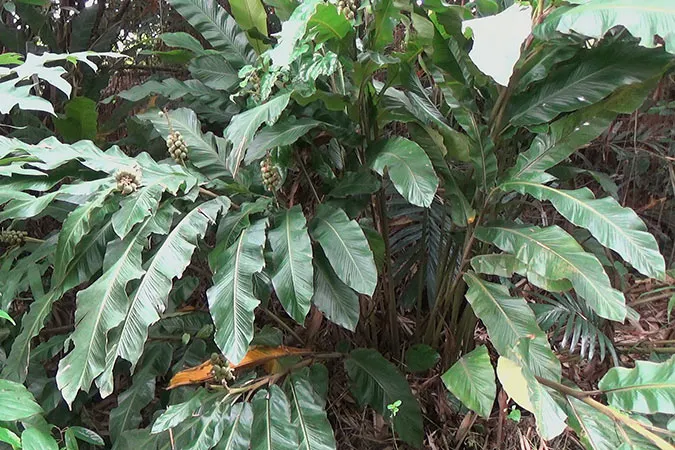Kamijara (Alpinia malaccensis) is a species of plant in the Zingiberaceae, a shrub with long leaves, flowers and fruit in panicles, hairy, grows in the shade and produces galangal which has medicinal properties.
A. malaccensis grows firmly upright, 2-4 m high, green and parts smell aromatic when squeezed. The leaf blade is narrow lanceolate, 40-90 cm long, 7-20) cm wide and has a sharp tip. A linear bone in the center forms a trench with many veins sideways. The stalk is 3-7 cm long.
The margins are thickened and even. The upper surface is dark green and shiny, the lower surface is light green and has a tight velvet hair or at least the edges and undersides of the main leaf bones. Midrib hair tightly near the leaf blade. The ligules are flat, up to 1 cm long and hairy.
Inflorescences in the form of grains (racemose) on the shoots, erect or slightly curved, up to 35 cm long, while the buds are protected by two long sheaths of flowers. The panicle stalks are erect, stocky, green, densely haired, supporting up to 60 or more single flowers, some of the lowest may be in pairs of 2 blossoms.
Flowers have secondary protective leaves up to 2-4 cm long, white, some tipped purple-red. Fruit will have a size of 0.9x1.2 cm and have tight hair. The petals are 3.2 cm long, 3 taju, white and velvet hair on the outside. Crown with tubes up to 1.2 cm, white, top taju up to 4x2.5 cm, tight hair on the outside and 2 taju on the sides slightly smaller.
Labellum egg-shaped, wide, up to 6 cm long and the widest part up to more than 3 cm, the edges are wrinkled, one end forms a protruding edge, the inside is red with yellow spots, the edges are yellow with stripes. the line is red-purple.
The fruits are capsule-shaped and tends to be round, up to 3 cm in diameter, stiff hair and short and ripe red orange. Seeds have 3-4 corners and are 5 mm long. Kamijara is commonly found in primary forests and other wild areas which are cool and humid.
All parts smell harsh and contain some kind of essential oil. Rhizome is used as a vegetable or cooking spice, treating ulcers and wounds, mixed with betel nuts and chewed to filter the voice of the singer. The rind of the fruit squeezed in water is used to clean and scent clothes and hair.
Kingdom: Plantae
Phylum: Tracheophyta
Subphylum: Angiospermae
Class: Liliopsida
Order: Zingiberales
Family: Zingiberaceae
Genus: Alpinia
Species: Alpinia malaccensis
A. malaccensis grows firmly upright, 2-4 m high, green and parts smell aromatic when squeezed. The leaf blade is narrow lanceolate, 40-90 cm long, 7-20) cm wide and has a sharp tip. A linear bone in the center forms a trench with many veins sideways. The stalk is 3-7 cm long.
The margins are thickened and even. The upper surface is dark green and shiny, the lower surface is light green and has a tight velvet hair or at least the edges and undersides of the main leaf bones. Midrib hair tightly near the leaf blade. The ligules are flat, up to 1 cm long and hairy.
Inflorescences in the form of grains (racemose) on the shoots, erect or slightly curved, up to 35 cm long, while the buds are protected by two long sheaths of flowers. The panicle stalks are erect, stocky, green, densely haired, supporting up to 60 or more single flowers, some of the lowest may be in pairs of 2 blossoms.
Flowers have secondary protective leaves up to 2-4 cm long, white, some tipped purple-red. Fruit will have a size of 0.9x1.2 cm and have tight hair. The petals are 3.2 cm long, 3 taju, white and velvet hair on the outside. Crown with tubes up to 1.2 cm, white, top taju up to 4x2.5 cm, tight hair on the outside and 2 taju on the sides slightly smaller.
Labellum egg-shaped, wide, up to 6 cm long and the widest part up to more than 3 cm, the edges are wrinkled, one end forms a protruding edge, the inside is red with yellow spots, the edges are yellow with stripes. the line is red-purple.
The fruits are capsule-shaped and tends to be round, up to 3 cm in diameter, stiff hair and short and ripe red orange. Seeds have 3-4 corners and are 5 mm long. Kamijara is commonly found in primary forests and other wild areas which are cool and humid.
All parts smell harsh and contain some kind of essential oil. Rhizome is used as a vegetable or cooking spice, treating ulcers and wounds, mixed with betel nuts and chewed to filter the voice of the singer. The rind of the fruit squeezed in water is used to clean and scent clothes and hair.
Kingdom: Plantae
Phylum: Tracheophyta
Subphylum: Angiospermae
Class: Liliopsida
Order: Zingiberales
Family: Zingiberaceae
Genus: Alpinia
Species: Alpinia malaccensis
